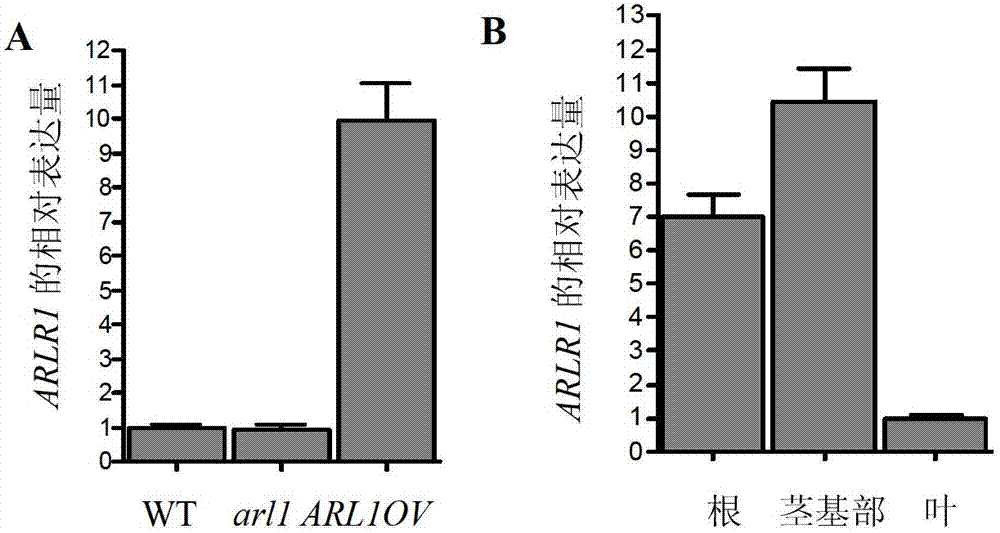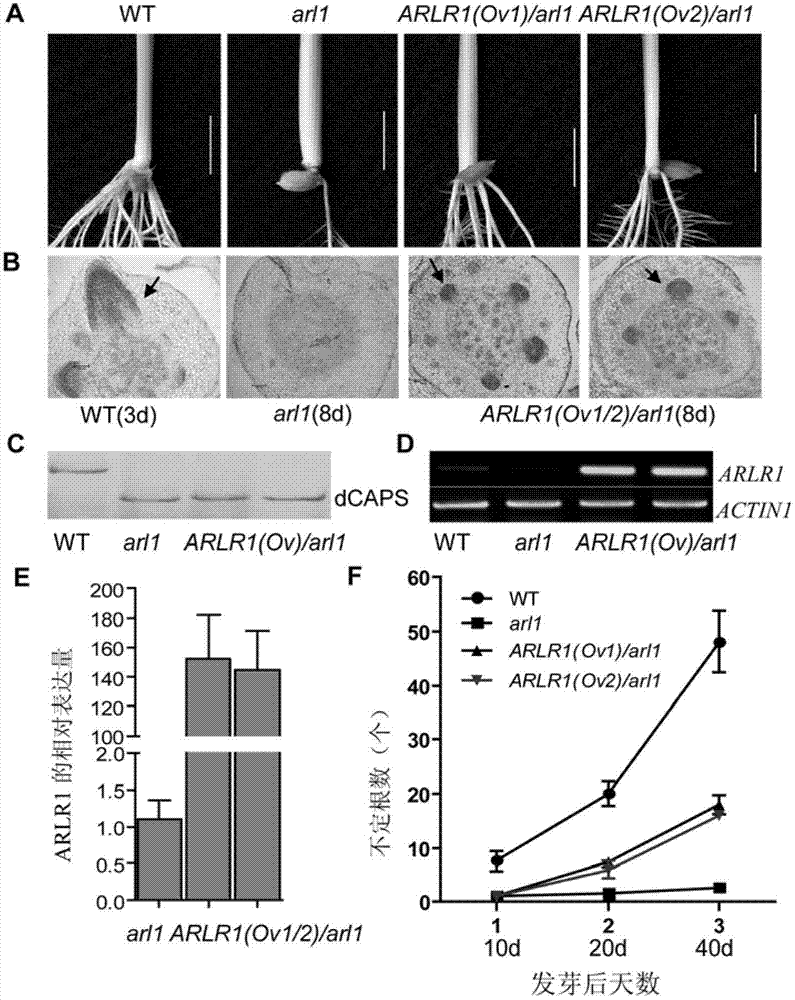Rice adventitious root control gene ARLR1 and application thereof
A gene and rice technology, which is applied in the field of transgene recovery and RNAi technology experimental identification of the gene, can solve the problems of poor tissue morphology and fragmented related information
- Summary
- Abstract
- Description
- Claims
- Application Information
AI Technical Summary
Problems solved by technology
Method used
Image
Examples
Embodiment 1
[0051] Embodiment 1, ARLR1 gene cloning, identification
[0052]The genes of wild type (WT, Imperata chinensis can be purchased from the seed bank of China Rice Research Institute), arl1 mutant (screened by our laboratory) and ARL1 enhanced expression material (ARL1OV) (created by our laboratory) were analyzed by gene chip expression differences, and found that the gene ARLR1 was up-regulated in the ARL1-enhanced expression material and down-regulated in the mutant ( figure 1 ), this result was also verified by quantitative RT-PCR (qRT-PCR) ( figure 1 ). The qRT-PCR experiment uses Roche's Real Time PCR special reagent LightCycler? 480 SYBR Green I Master, and the PCR reaction is carried out on the LightCycler ? 480 (Roche, USA) quantitative PCR instrument. We cloned the gene by PCR method. Sequencing analysis showed that the sequence of the coding region of the gene as shown in SEQ ID NO: 1 is 1368bp (including stop codon), encoding a protein containing 455 amino acids as ...
Embodiment 2
[0054] Embodiment 2, rice transgenic
[0055] The rice genetic transformation system mediated by Agrobacterium bacterium (EHA105) was optimized based on the method reported by Hiei et al. (1994). The specific process is as follows:
[0056] Preparation of rice mature embryo callus:
[0057] After husking the mature seeds of rice (Imperata chinensis, SSBM), select the plump, smooth seeds without bacteria spots and put them into a beaker, and disinfect them with 70% (volume ratio concentration) alcohol for 2 minutes;
[0058] Pour off the alcohol and add 25% (v / v) NaClO solution to disinfect for 30 minutes;
[0059] Pour off the NaClO solution, wash 5 times with sterile water, and soak in sterile water for 30 minutes for the last time;
[0060] Pour off the sterile water, put the seeds on sterile filter paper to blot dry, put the seeds flat in the mature embryo induction medium of indica rice, and culture them in the dark at 28°C for 10 days;
[0061] Open the petri dish on ...
Embodiment 3
[0099] Example 3, Enhanced expression of ARLR1 gene in arl1 mutant
[0100] Enhanced expression vector P 35S ::Build of ARLR:
[0101] The full-length cDNA sequence of ARLR (shown in SEQ ID NO: 1) was cloned by PCR amplification method. The primer sequences are as follows, and KpnI and XbaI recognition sites (underlined) are added to the ends of the upstream and downstream primers respectively.
[0102] Upstream primer: 5′AAAA GGTACC ATGCAGCAGCAGCAGCAG 3′
[0103] Downstream primer: 5′ACGA TCTAGA TCAGAACTCCGGCAAGAACTCCGT 3′
[0104] The template used in the PCR reaction was: 7-day-old seedling SSBM wild-type cDNA, and the polymerase used was PrimeSTAR HS DNA Polymerase (Baosheng Company).
[0105] The PCR system is: DNA 100 ng, upstream primer 0.2μM, downstream primer 0.2μM, 10X PCR buffer 2μl, dNTP 0.2mM, TAQ DNA polymerase 1U (Baosheng), add ddH 2 0 to 20 μl.
[0106]The PCR reaction program was: denaturation at 98°C for 30 sec; 10 sec at 98°C, 7 sec at 60°C, 90 sec...
PUM
 Login to View More
Login to View More Abstract
Description
Claims
Application Information
 Login to View More
Login to View More - R&D Engineer
- R&D Manager
- IP Professional
- Industry Leading Data Capabilities
- Powerful AI technology
- Patent DNA Extraction
Browse by: Latest US Patents, China's latest patents, Technical Efficacy Thesaurus, Application Domain, Technology Topic, Popular Technical Reports.
© 2024 PatSnap. All rights reserved.Legal|Privacy policy|Modern Slavery Act Transparency Statement|Sitemap|About US| Contact US: help@patsnap.com










